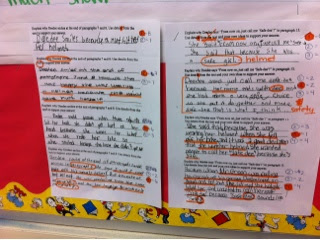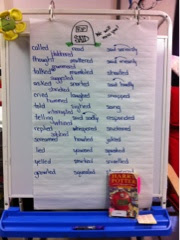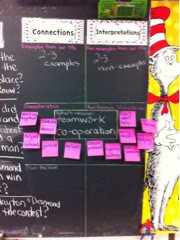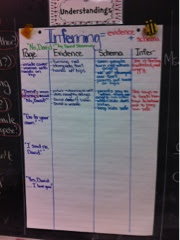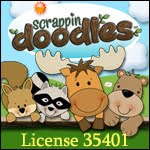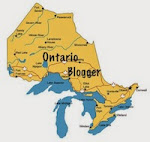So many things have been going on in our Literacy Workshop classes...we are just a whirlwind of activity these days!!
This is the first anchor chart/activity we did for inferring. We read "The Little Red Pen" and inferred the character's traits based on their actions and words.
We are also working on answering reading comprehension questions using evidence and details to support our ideas. The Grade 3's in Ontario all write a standardized test in the spring and this is part of the process in getting them ready. I cut up four possible answers (an A, B, C and D graded answer) and then had the students decide what grade each answer should get. You can see the votes for each question on the right hand side, with the actual mark being highlighted in orange. It provided some great discussion as the students really had to give a reason for their grades and we took some time to dive deeper into what makes a B a B and an A an A!!
We are working on narrative writing and so...we had a funeral for said! I was very surprised by the amount of coaching my students needed for this! It took a lot of time to coax the ideas out of them and even then some really struggled with giving a different way of saying "said"...something to come back to for sure.
This is our narrative writing anchor chart. The small paper you can see to the right is a sample story that we colour coded according to the 4 elements on the chart.
We have been continuing with our Book of the Week, but a lot of the work has shifted to the students. We are no longer working in small groups and answering orally but working towards writing our answers out on paper. A big jump for some of my little 3's.
Here is some great predicting/inferring my students have been doing as well! I was so proud with how much they came up with before we even read the book. Just from the cover and the title.
Here's the beginning of our chart showing how we add our evidence to our schema to create an inference. For this we used the book "No, David!" (always a favourite!). The rest of the chart will be filled in by the students in small groups which I will then assess to see where we are and how much more teaching is needed. From there I will be moving into more independent inferring activities in order to assess this reading skill.
Whew!! And that's that.
What are you working on in literacy?
Have any great inferring lessons/activities I should try?
What are some great picture books for inferring??


